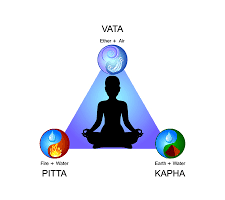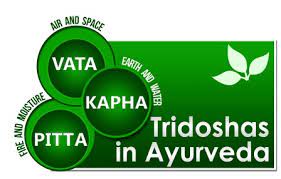Tridosh in Ayurveda
According to philosophy, the universal life force manifests as three different energies or doshas, known as Vata, Pitta and Kapha. These are mentioned in Tridosh in Ayurveda.We are all made up of a unique combination of these three forces. Although everyone has something in common, most people have one or two doshas in abundance. This unique combination is determined at the time of conception and is your own personal blueprint, or Prakriti (Prakriti). As you move forward in life.

Tridosh in Ayurveda
Ayurveda has been called the “knowledge of life”. Because it dates back 5,000 years to the ancient Sanskrit texts, the Vedas. It is a system of healing that examines the emotional nature and spiritual outlook within the context of the universe.
The ratio of each of the Tridoshas of Ayurveda changes continuously according to your environment, your diet, season, climate, your age and many other factors. As they move in and out of balance, doshas can affect your health, energy level and general mood.
Ayurveda believes that all bodily processes are regulated by the balance of the three doshas.
Vata Dosha
Vata governs the movement of the body and mind. Excessive Vata causes anxiety, insomnia, constipation, etc. Vata controls blood supply, breathing, mental thoughts, etc. Vata activates the nervous system, hearing, speech. Vata increases enthusiasm and creativity. Vata also affects pitta and kapha. Vata dosha is often the first cause of the disease. Air is also called Vayu.

Tridosh in Ayurveda
Consisting of air and ethereal elements, it is the principle force of motion in body and mind. When the Vata dosha is healthy, the body’s movements are smooth, unobstructed, and yet controlled. When out of balance, movements become erratic, excessive, decreased or inhibited.
To understand Vata dosha, it is necessary to understand its properties. Vata dosha is mild, dry, cold, hard, rough, sharp, subtle, flowing and clear. A body and mind in which Vata dosha predominates expresses or reflects these qualities.
The vata dosha is best understood in terms of its constituent parts, its updoshas, which are the five types of vata or the five types of motion. Each Updosha defines the direction of motion and controls specific actions in the body.
Like Kapha and Pitta, it also gives different effects in different places of the body. Which is the following –
When Vata is present in a person’s chest, navel and nose. So it controls the person’s consciousness, speaking, respiratory action etc. smoothly. This Vata is called Udana.
Helps in assimilation when in the stomach. This vata is called equal.
When Vata is present in the urinary tract, genitals, abdomen and thighs. So it controls excreta, semen, menstrual flow. This Vata is called Apana Vata.
When Vata is located in the middle of the brain. So it helps in controlling the vata activities of the body. This Vata is known as Prana.
When Vata is located in the heart, the nervous system, the spinal cord. So it controls the expansion and contraction of flesh, animals, excitement, secretion, sweating etc. This Vata is called Vyana.
Kapha dosha
Kapha is believed to be formed from Apatattva. Kapha embodies the elements in the body, increases immunity. Kapha governs joint lubricant, wound healing, strength, balance, memory, heart and lungs. Kapha gives the qualities of affection, love, peacefulness, jealousy. Excess Kapha causes obesity, lethargy and allergies.

Tridosh in Ayurveda 3
Kapha is composed of the components of earth and water. It is heavy, slow, cold, smooth, smooth, delicate, thick, stable, voluminous and cloudy. Kapha gives structure and strength to all things; It provides the necessary harmony to maintain a particular look.
Kapha additionally hydrates all cells and structures, lubricates joints, saturates the skin, maintains immunity and protects tissues. Kapha is often associated with water energy, and with love and compassion. Due to the excess of Kapha in different parts of the body, it is also known by different names.
If Kapha is in the brain, it is called Tarpak. The function of this type of Kapha is to control the touch, smell, hearing, sight and taste glands.
The phlegm of the stomach moistens the food and cools the stomach. This type of Kapha is called Kledak.
Chest kapha supplies blood circulation, moisture and fluids in the body. This Kapha is called Avalambaka Kapha.
Stagnant phlegm in the joints is called mucus. The function of this type of Kapha is to lubricate the body.
The phlegm found in the tongue is known as Bodhak Kapha. Bodhaka Kapha plays its role in the production of saliva. Through this phlegm, food is carried down the throat.
Now in such a situation, if a person eats a lot of fatty and greasy foods, takes more sleep, stays in winter place for a long time, sleeps more during the day due to night, is not very physically active. That is, they do very little physical labor. So all these reasons cause Kapha dosha imbalance.
Now in such a situation, if the kapha of a person becomes unbalanced, then what kind of symptoms are seen in it –
There is weakness in digestion.
Salty taste remains in the mouth. Like salt water dissolved in your mouth.
Yellowing starts in the body.
Feeling of heaviness or coldness in the body.
The limbs do not move properly. It starts getting stuck in the problem.
pitta dosha
Pitta is believed to originate from the principles Apa and Agni. Pitta controls body heat, metabolism, transformation of mind and body, digestion, senses, conscience, etc. Aati Pitta causes anger, criticism, ulcers, rashes, etc. A balanced Pitta develops leadership qualities.

Tridosh in Ayurveda 4
Each dosha is present in the body with a dominant quality of its own and it also shares another quality with one of the other two doshas. Pitta is known as fire in the body. But it exists in the form of water or oil. When it is explained that it exists in the form of water or oil, it is basically in the form of acid because it cannot exist in the body like fire.
The word pitta is derived from the Sanskrit word ‘tapa’ which means heat. Pitta is bodily energy that is liquid because it combines the elements of fire and water. This dosha controls digestion and transformation in the body. Pitta dosha is the hottest dosha as it is associated with fire. The effect of pitta on the body is heat-enhancing. This causes swelling, anger, buildup of heat in the body and many other symptoms.
Like phlegm, the presence of bile in different organs has different effects –
When pitta is located in the heart of a person. So controls the temperature of a person’s body, its complexion, and its brightness. This pitta is known as a seeker.
bile is present in the skin. So it controls the moisture, skin and heat of the body. This pitta has been called a critic in Ayurveda.
When bile is in the small intestine and stomach. So in this case it controls the formation of pancreatic and bile juices of the body. This bile is called digester.
When bile is present in the eyes of a person. So it is called Bhajaka Pitta. The work of this type of pitta is helpful in the eyesight.
Which bile is located in liver, stomach, pancreas. And its job is to strengthen the digestive system and make blood cells. This pitta is known as dye.
To disturb the balance of pitta in the body, there are some foods which are responsible for this. If you are fond of eating more salty, spicy, spicy food. So the defect of pitta dosha will remain in your body. Changes occur in the digestive system when there is fluctuation in Pitta dosha in the body.
If there is an excess of pitta in a person or if the pitta dosha becomes unbalanced, then what are the symptoms?
Excess of Kodhra is seen.
the envy
The habit of dominating someone else.
instability etc.
See More
Introduction of Ayurveda-What is Ayurveda?-Ayurveda for Beginners
Guidelines and basic principles of Ayurveda
Types of food described in Ayurveda
Faq
1 How many types of defects are mentioned in Ayurveda?
2 Which doshas are mentioned in Ayurveda?
3 Pitta originates from which elements?
Webstories –